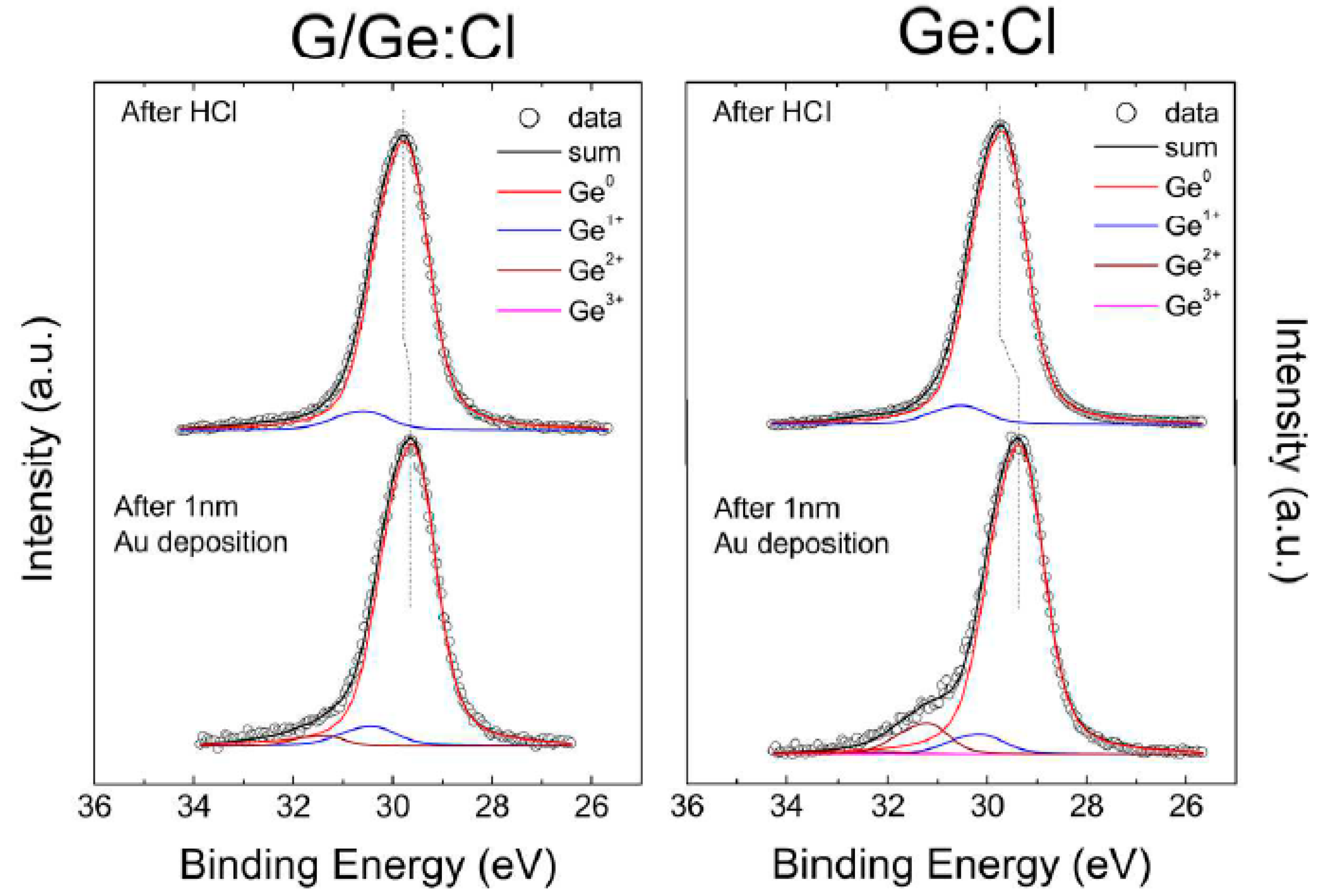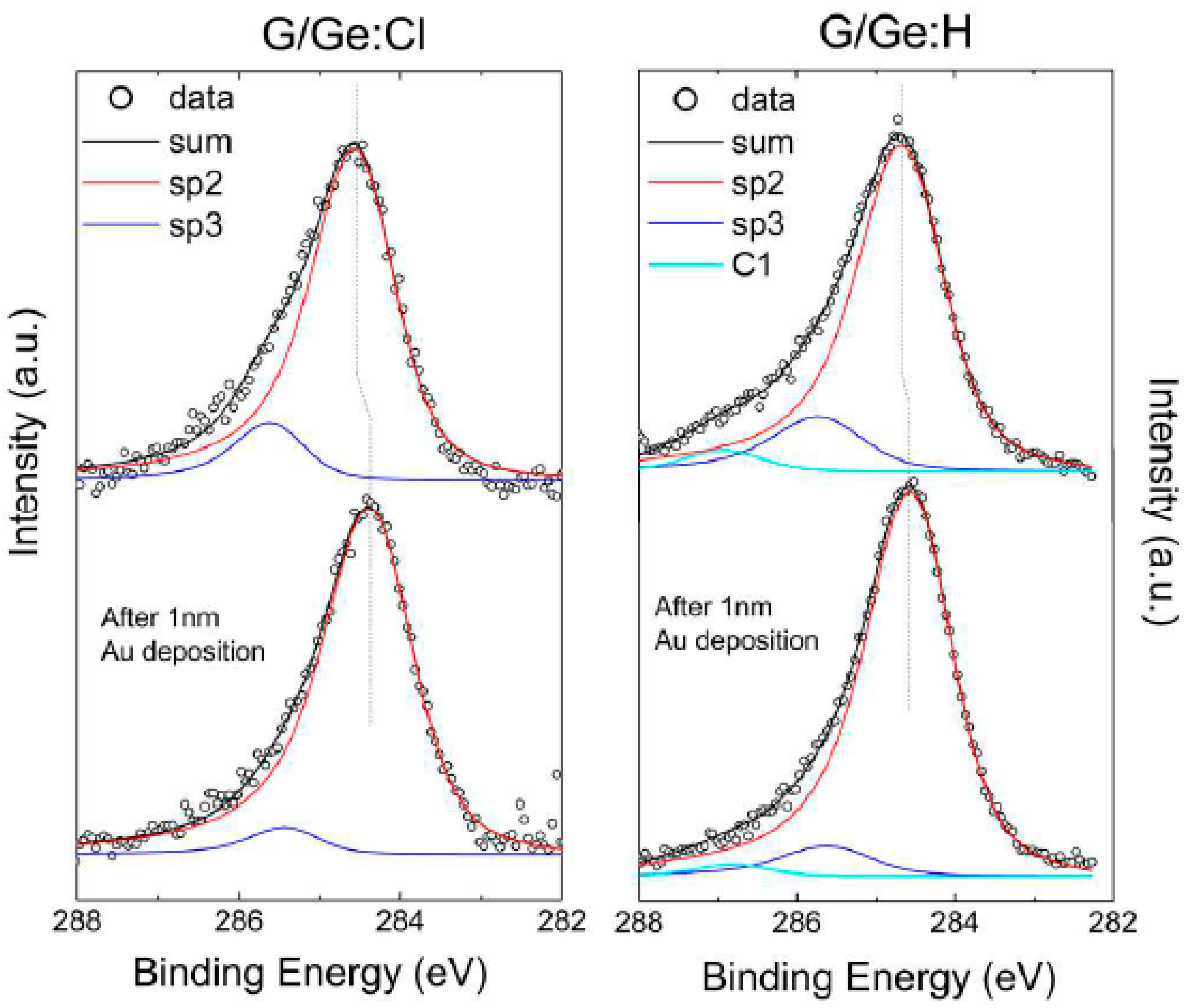Reduction of Schottky Barrier Height at Graphene/Germanium Interface with Surface Passivation
Abstract
:1. Introduction
2. Materials and Methods
3. Results
4. Discussion
5. Conclusions
Author Contributions
Funding
Conflicts of Interest
References
- Di Bartolomeo, A. Graphene Schottky Diodes: An Experimental Review of the Rectifying Graphene/Semiconductor Heterojunction. Phys. Rep. 2016, 606, 1–58. [Google Scholar] [CrossRef]
- Yang, H.; Heo, J.; Park, S.; Song, H.J.; Seo, D.H.; Byun, K.-E.; Kim, P.; Yoo, I.; Chung, H.-J.; Kim, K. Graphene Barristor, a Triode Device with a Gate-Controlled Schottky Barrier. Science 2012, 336, 1140–1143. [Google Scholar] [CrossRef] [PubMed]
- Ojeda-Aristizabal, C.; Bao, W.; Fuhrer, M.S. Thin-Film Barristor: A Gate-Tunable Vertical Graphene-Pentacene Device. Phys. Rev. B Condens. Matter Mater. Phys. 2013, 88, 3–6. [Google Scholar] [CrossRef]
- An, Y.; Behnam, A.; Pop, E.; Ural, A. Metal-Semiconductor-Metal Photodetectors Based on Graphene/p-Type Silicon Schottky Junctions. Appl. Phys. Lett. 2013, 102, 013110. [Google Scholar] [CrossRef]
- Goykhman, I.; Sassi, U.; Desiatov, B.; Mazurski, N.; Milana, S.; De Fazio, D.; Eiden, A.; Khurgin, J.; Shappir, J.; Levy, U.; et al. On-Chip Integrated, Silicon-Graphene Plasmonic Schottky Photodetector with High Responsivity and Avalanche Photogain. Nano Lett. 2016, 16, 3005–3013. [Google Scholar] [CrossRef]
- Casalino, M.; Sassi, U.; Goykhman, I.; Eiden, A.; Lidorikis, E.; Milana, S.; De Fazio, D.; Tomarchio, F.; Iodice, M.; Coppola, G.; et al. Vertically Illuminated, Resonant Cavity Enhanced, Graphene-Silicon Schottky Photodetectors. ACS Nano 2017, 11, 10955–10963. [Google Scholar] [CrossRef]
- Amirmazlaghani, M.; Raissi, F.; Habibpour, O.; Vukusic, J.; Stake, J. Graphene-Si Schottky IR Detector. IEEE J. Quantum Electron. 2013, 49, 589–594. [Google Scholar] [CrossRef]
- Luongo, G.; Giubileo, F.; Genovese, L.; Iemmo, L.; Martucciello, N.; Di Bartolomeo, A. I-V and C-V Characterization of a High-Responsivity Graphene/Silicon Photodiode with Embedded MOS Capacitor. Nanomaterials 2017, 7, 158. [Google Scholar] [CrossRef]
- Luongo, G.; Di Bartolomeo, A.; Giubileo, F.; Chavarin, C.A.; Wenger, C. Electronic Properties of Graphene/p-Silicon Schottky Junction. J. Phys. D Appl. Phys. 2018, 51, 255305. [Google Scholar] [CrossRef]
- Li, X.; Zhu, H.; Wang, K.; Cao, A.; Wei, J.; Li, C.; Jia, Y.; Li, Z.; Li, X.; Wu, D. Graphene-on-Silicon Schottky Junction Solar Cells. Adv. Mater. 2010, 22, 2743–2748. [Google Scholar] [CrossRef]
- Miao, X.; Tongay, S.; Petterson, M.K.; Berke, K.; Rinzler, A.G.; Appleton, B.R.; Hebard, A.F. High Efficiency Graphene Solar Cells by Chemical Doping. Nano Lett. 2012, 12, 2745–2750. [Google Scholar] [CrossRef]
- Song, Y.; Li, X.; Mackin, C.; Zhang, X.; Fang, W.; Palacios, T.; Zhu, H.; Kong, J. Role of Interfacial Oxide in High-Efficiency Graphene-Silicon Schottky Barrier Solar Cells. Nano Lett. 2015, 15, 2104–2110. [Google Scholar] [CrossRef]
- Van’t Erve, O.M.J.; Friedman, A.L.; Cobas, E.; Li, C.H.; Robinson, J.T.; Jonker, B.T. Low-Resistance Spin Injection into Silicon Using Graphene Tunnel Barriers. Nat. Nanotechnol. 2012, 7, 737–742. [Google Scholar] [CrossRef]
- Van’t Erve, O.M.J.; Friedman, A.L.; Cobas, E.; Li, C.H.; Hanbicki, A.T.; McCreary, K.M.; Robinson, J.T.; Jonker, B.T. A Graphene Solution to Conductivity Mismatch: Spin Injection from Ferromagnetic Metal/Graphene Tunnel Contacts into Silicon. J. Appl. Phys. 2013, 113, 17C502. [Google Scholar] [CrossRef]
- Lee, M.H.; Cho, Y.; Byun, K.E.; Shin, K.W.; Nam, S.G.; Kim, C.; Kim, H.; Han, S.A.; Kim, S.W.; Shin, H.J.; et al. Two-Dimensional Materials Inserted at the Metal/Semiconductor Interface: Attractive Candidates for Semiconductor Device Contacts. Nano Lett. 2018, 18, 4878–4884. [Google Scholar] [CrossRef]
- Courtin, J.; Le Gall, S.; Chretien, P.; Moréac, A.; Delhaye, G.; Lépine, B.; Tricot, S.; Turban, P.; Schieffer, P.; Le Breton, J.-C. Low Schottky Barrier Height and Transport Mechanism in Gold-Graphene-Silicon (001) Heterojunctions. Nanoscale Adv. 2019, 1, 3372–3378. [Google Scholar] [CrossRef]
- Le Breton, J.C.; Tricot, S.; Delhaye, G.; Lépine, B.; Turban, P.; Schieffer, P. Band Alignments in Fe/Graphene/Si (001) Junctions Studied by x-Ray Photoemission Spectroscopy. Appl. Phys. Lett. 2016, 109, 051601. [Google Scholar] [CrossRef]
- Cantoni, M.; Petti, D.; Rinaldi, C.; Bertacco, R. Bandstructure Line-up of Epitaxial Fe/MgO/Ge Heterostructures: A Combined x-Ray Photoelectron Spectroscopy and Transport Study. Appl. Phys. Lett. 2011, 98, 032104. [Google Scholar] [CrossRef]
- Jain, A.; Louahadj, L.; Peiro, J.; Le Breton, J.C.; Vergnaud, C.; Barski, A.; Beigné, C.; Notin, L.; Marty, A.; Baltz, V.; et al. Electrical Spin Injection and Detection at Al2O3/n-Type Germanium Interface Using Three Terminal Geometry. Appl. Phys. Lett. 2011, 99, 162102. [Google Scholar] [CrossRef]
- Thathachary, A.V.; Bhat, K.N.; Bhat, N.; Hegde, M.S. Fermi Level Depinning at the Germanium Schottky Interface through Sulfur Passivation. Appl. Phys. Lett. 2010, 96, 152108. [Google Scholar] [CrossRef]
- Maeda, T.; Takagi, S.; Ohnishi, T.; Lippmaa, M. Sulfur Passivation of Ge (0 0 1) Surfaces and Its Effects on Schottky Barrier Contact. Mater. Sci. Semicond. Process. 2006, 9, 706–710. [Google Scholar] [CrossRef]
- Roy, A.M.; Lin, J.Y.J.; Saraswat, K.C. Specific Contact Resistivity of Tunnel Barrier Contacts Used for Fermi Level Depinning. IEEE Electron Device Lett. 2010, 31, 1077–1079. [Google Scholar] [CrossRef]
- Roy, A.M.; Lin, J.; Saraswat, K.C. The Effect of Fixed Charge in Tunnel-Barrier Contacts for Fermi-Level Depinning in Germanium. IEEE Electron Device Lett. 2012, 33, 761–763. [Google Scholar] [CrossRef]
- Zhou, Y.; Ogawa, M.; Han, X.; Wang, K.L. Alleviation of Fermi-Level Pinning Effect on Metal/Germanium Interface by Insertion of an Ultrathin Aluminum Oxide. Appl. Phys. Lett. 2008, 93, 202105. [Google Scholar] [CrossRef]
- Nishimura, T.; Kita, K.; Toriumi, A. A Significant Shift of Schottky Barrier Heights at Strongly Pinned Metal/Germanium Interface by Inserting an Ultra-Thin Insulating Film. Appl. Phys. Express 2008, 1, 051406. [Google Scholar] [CrossRef]
- Khurelbaatar, Z.; Kil, Y.H.; Yun, H.J.; Shim, K.H.; Nam, J.T.; Kim, K.S.; Lee, S.K.; Choi, C.J. Modification of Schottky Barrier Properties of Au/n-Type Ge Schottky Barrier Diode Using Monolayer Graphene Interlayer. J. Alloys Compd. 2014, 614, 323–329. [Google Scholar] [CrossRef]
- Kobayashi, M.; Kinoshita, A.; Saraswat, K.; Wong, H.S.P.; Nishi, Y. Fermi Level Depinning in Metal/Ge Schottky Junction for Metal Source/Drain Ge Metal-Oxide-Semiconductor Field-Effect-Transistor Application. J. Appl. Phys. 2009, 105, 023702. [Google Scholar] [CrossRef]
- Seah, M.P. Letters to the Editor. Surf. Interface Anal. 1989, 14, 488. [Google Scholar] [CrossRef]
- Schmeisser, D.; Schnell, R.D.; Bogen, A.; Himpsel, F.J.; Rieger, D.; Landgren, G.; Morar, J.F. Surface Oxidation States of Germanium. Surf. Sci. 1986, 172, 455–465. [Google Scholar] [CrossRef]
- Lu, Z.H. Air-Stable Cl-Terminated Ge(111). Appl. Phys. Lett. 1995, 68, 520–522. [Google Scholar] [CrossRef]
- Nikitin, A.; Näslund, L.-Å.; Zhang, Z.; Nilsson, A. C–H Bond Formation at the Graphite Surface Studied with Core Level Spectroscopy. Surf. Sci. 2008, 602, 2575–2580. [Google Scholar] [CrossRef]
- Cunge, G.; Ferrah, D.; Petit-Etienne, C.; Davydova, A.; Okuno, H.; Kalita, D.; Bouchiat, V.; Renault, O. Dry Efficient Cleaning of Poly-Methyl-Methacrylate Residues from Graphene with High-Density H2 and H2-N2 Plasmas. J. Appl. Phys. 2015, 118, 123302. [Google Scholar] [CrossRef]
- Giovannetti, G.; Khomyakov, P.; Brocks, G.; Karpan, V.; van den Brink, J.; Kelly, P. Doping Graphene with Metal Contacts. Phys. Rev. Lett. 2008, 101, 026803. [Google Scholar] [CrossRef]
- Lieten, R.R.; Afanas’ev, V.V.; Thoan, N.H.; Degroote, S.; Walukiewicz, W.; Borghs, G. Mechanisms of Schottky Barrier Control on N-Type Germanium Using Ge3N4interlayers. J. Electrochem. Soc. 2011, 158, 358–362. [Google Scholar] [CrossRef]
- Dimoulas, A.; Tsipas, P.; Sotiropoulos, A.; Evangelou, E.K. Fermi-Level Pinning and Charge Neutrality Level in Germanium. Appl. Phys. Lett. 2006, 89, 12–15. [Google Scholar] [CrossRef]
- Lin, W.-H.; Chen, T.-H.; Chang, J.-K.; Taur, J.-I.; Lo, Y.-Y.; Lee, W.-L.; Chang, C.-S.; Su, W.-B.; Wu, C.-I. A Direct and Polymer-Free Method for Transferring Graphene Grown by Chemical Vapor Deposition to Any Substrate. ACS Nano 2014, 8, 1784–1791. [Google Scholar] [CrossRef]
- Rivillon, S.; Chabal, Y.J.; Amy, F.; Kahn, A. Hydrogen Passivation of Germanium (100) Surface Using Wet Chemical Preparation. Appl. Phys. Lett. 2005, 87, 253101. [Google Scholar] [CrossRef]
- Xu, Y.; He, K.T.; Schmucker, S.W.; Guo, Z.; Koepke, J.C.; Wood, J.D.; Lyding, J.W.; Aluru, N.R. Inducing Electronic Changes in Graphene through Silicon (100) Substrate Modification. Nano Lett. 2011, 11, 2735–2742. [Google Scholar] [CrossRef]



| Surface Treatment | G/Ge | Au/G/Ge | Au/Ge |
|---|---|---|---|
| HF | 0.49 | 0.53 | 0.78 |
| HCl | 0.31 | 0.50 | 0.77 |
© 2019 by the authors. Licensee MDPI, Basel, Switzerland. This article is an open access article distributed under the terms and conditions of the Creative Commons Attribution (CC BY) license (http://creativecommons.org/licenses/by/4.0/).
Share and Cite
Courtin, J.; Moréac, A.; Delhaye, G.; Lépine, B.; Tricot, S.; Turban, P.; Schieffer, P.; Le Breton, J.-C. Reduction of Schottky Barrier Height at Graphene/Germanium Interface with Surface Passivation. Appl. Sci. 2019, 9, 5014. https://doi.org/10.3390/app9235014
Courtin J, Moréac A, Delhaye G, Lépine B, Tricot S, Turban P, Schieffer P, Le Breton J-C. Reduction of Schottky Barrier Height at Graphene/Germanium Interface with Surface Passivation. Applied Sciences. 2019; 9(23):5014. https://doi.org/10.3390/app9235014
Chicago/Turabian StyleCourtin, Jules, Alain Moréac, Gabriel Delhaye, Bruno Lépine, Sylvain Tricot, Pascal Turban, Philippe Schieffer, and Jean-Christophe Le Breton. 2019. "Reduction of Schottky Barrier Height at Graphene/Germanium Interface with Surface Passivation" Applied Sciences 9, no. 23: 5014. https://doi.org/10.3390/app9235014
APA StyleCourtin, J., Moréac, A., Delhaye, G., Lépine, B., Tricot, S., Turban, P., Schieffer, P., & Le Breton, J.-C. (2019). Reduction of Schottky Barrier Height at Graphene/Germanium Interface with Surface Passivation. Applied Sciences, 9(23), 5014. https://doi.org/10.3390/app9235014





